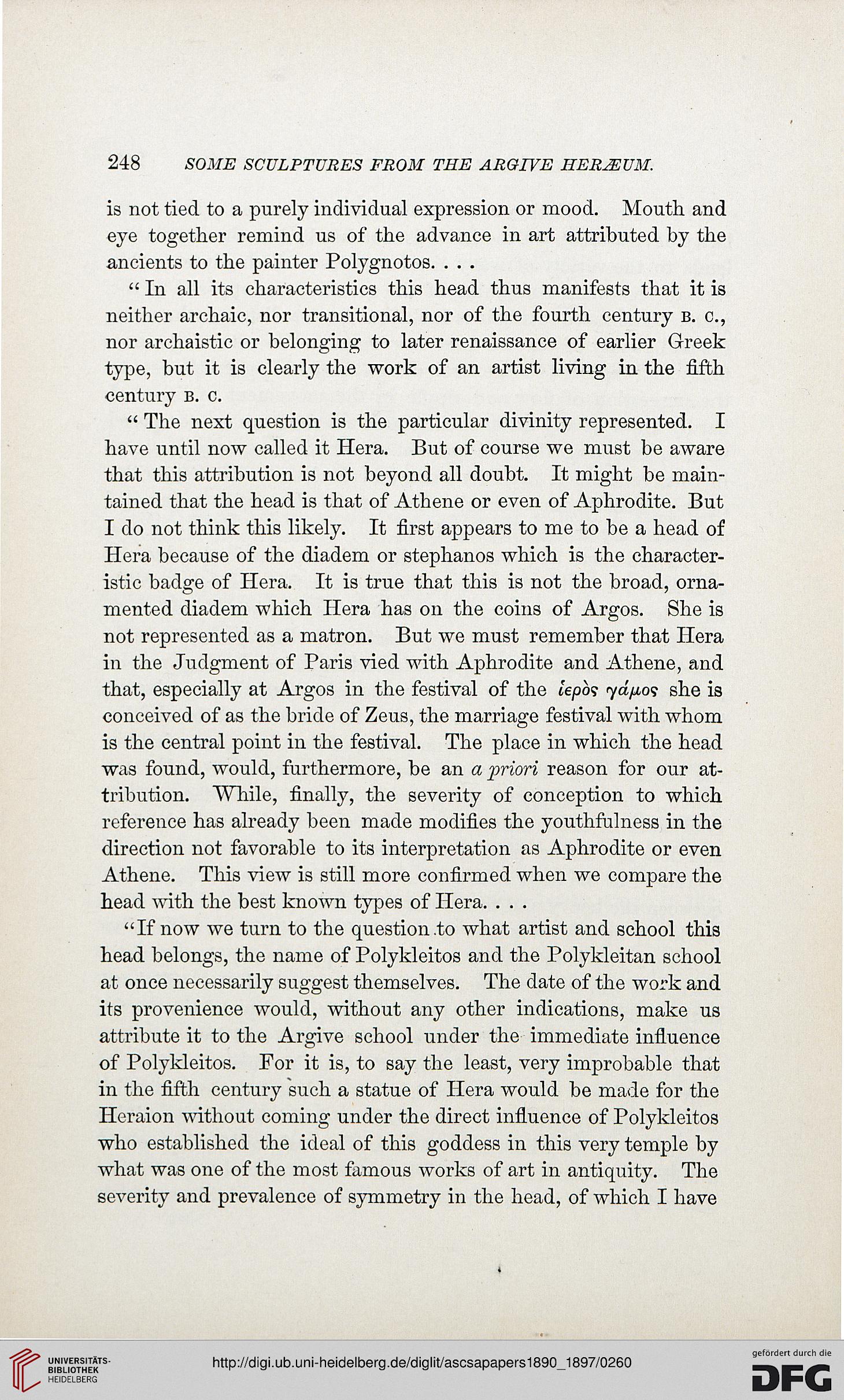248 SOME SCULPTURES FROM THE ARGUTE HERMUM.
is not tied to a purely individual expression or mood. Mouth and
eye together remind us of the advance in art attributed by the
ancients to the painter Polygnotos. . . .
" In all its characteristics this head thus manifests that it is
neither archaic, nor transitional, nor of the fourth century b. c,
nor archaistic or belonging to later renaissance of earlier Greek
type, but it is clearly the work of an artist living in the fifth
century b. c.
" The next question is the particular divinity represented. I
have until now called it Hera. But of course we must be aware
that this attribution is not beyond all doubt. It might be main-
tained that the head is that of Athene or even of Aphrodite. But
I do not think this likely. It first appears to me to be a head of
Hera because of the diadem or Stephanos which is the character-
istic badge of Hera. It is true that this is not the broad, orna-
mented diadem which Hera has on the coins of Argos. She is
not represented as a matron. But we must remember that Hera
in the Judgment of Paris vied with Aphrodite and Athene, and
that, especially at Argos in the festival of the iepo? 7^0? she is
conceived of as the bride of Zeus, the marriage festival with whom
is the central point in the festival. The place in which the head
was found, would, furthermore, be an a priori reason for our at-
tribution. While, finally, the severity of conception to which
reference has already been made modifies the youthfulness in the
direction not favorable to its interpretation as Aphrodite or even
Athene. This view is still more confirmed when we compare the
head with the best known types of Hera. . . .
"If now we turn to the question .to what artist and school this
head belongs, the name of Polykleitos and the Polykleitan school
at once necessarily suggest themselves. The date of the work and
its provenience would, without any other indications, make us
attribute it to the Argive school under the immediate influence
of Polykleitos. For it is, to say the least, very improbable that
in the fifth century such a statue of Hera would be made for the
Heraion without coming under the direct influence of Polykleitos
who established the ideal of this goddess in this very temple by
what was one of the most famous works of art in antiquity. The
severity and prevalence of symmetry in the head, of which I have
is not tied to a purely individual expression or mood. Mouth and
eye together remind us of the advance in art attributed by the
ancients to the painter Polygnotos. . . .
" In all its characteristics this head thus manifests that it is
neither archaic, nor transitional, nor of the fourth century b. c,
nor archaistic or belonging to later renaissance of earlier Greek
type, but it is clearly the work of an artist living in the fifth
century b. c.
" The next question is the particular divinity represented. I
have until now called it Hera. But of course we must be aware
that this attribution is not beyond all doubt. It might be main-
tained that the head is that of Athene or even of Aphrodite. But
I do not think this likely. It first appears to me to be a head of
Hera because of the diadem or Stephanos which is the character-
istic badge of Hera. It is true that this is not the broad, orna-
mented diadem which Hera has on the coins of Argos. She is
not represented as a matron. But we must remember that Hera
in the Judgment of Paris vied with Aphrodite and Athene, and
that, especially at Argos in the festival of the iepo? 7^0? she is
conceived of as the bride of Zeus, the marriage festival with whom
is the central point in the festival. The place in which the head
was found, would, furthermore, be an a priori reason for our at-
tribution. While, finally, the severity of conception to which
reference has already been made modifies the youthfulness in the
direction not favorable to its interpretation as Aphrodite or even
Athene. This view is still more confirmed when we compare the
head with the best known types of Hera. . . .
"If now we turn to the question .to what artist and school this
head belongs, the name of Polykleitos and the Polykleitan school
at once necessarily suggest themselves. The date of the work and
its provenience would, without any other indications, make us
attribute it to the Argive school under the immediate influence
of Polykleitos. For it is, to say the least, very improbable that
in the fifth century such a statue of Hera would be made for the
Heraion without coming under the direct influence of Polykleitos
who established the ideal of this goddess in this very temple by
what was one of the most famous works of art in antiquity. The
severity and prevalence of symmetry in the head, of which I have




